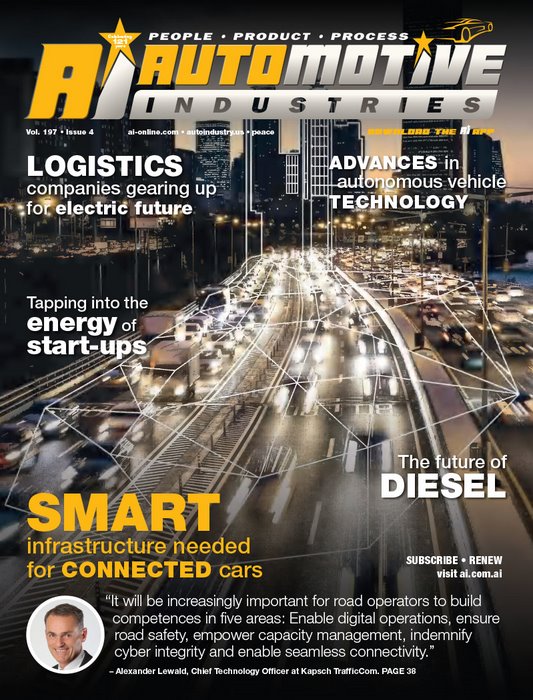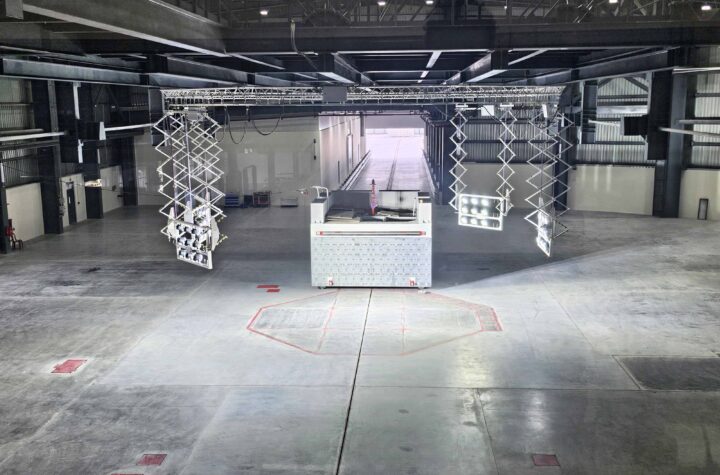
There is so much buzz about the coming of the autonomous car that it is easy to miss the fact that cars are already talking to each other.
After many years of research, standardization efforts and validation leading OEMs are equipping their mass platforms with car-to-car communication technology, points out Alexander Lewald, Chief Technology Officer at Kapsch TrafficCom. Kapsch has been investing in Car-to-Car communication for over 10 years.
Automotive Industries (AI) asked Lewald how the advent of the connected car will affect traffic management systems.
Lewald: With the appearance of car-to-car communication, connected traffic management systems are essential to act as mediator between divergent technologies and provide meaningful travel advisory to cars and smart phones. For the next few years we’ll be faced with a chicken and egg situation. The co-existence of connected and non-connected cars and cars equipped with different radios is a major challenge. A communication link with road infrastructure can bridge this situation and might be able to mitigate adverse effects on the quality of traffic and road safety.
AI: Will safety be improved?
Lewald: A higher level of road safety can be achieved, if the cars stay in contact with each other, but they need to also be aware of pedestrians and anything else that is moving in their vicinity. The connected road will listen to the communication between cars. By collected and processing this information, it will be possible to share travel insights with other road users, such as pedestrians and cyclists.
Road operators will be confronted with some big challenges over the medium term. These include traffic delays caused by the co-existence of conventional and connected cars; technology proliferation in smart transportation outpacing regulation and the impact of embedding vital information such as the driver’s license in the car.
A simulation by management consultancy Arthur D. Little of a major intersection of highway B3 in Frankfurt/Main (Germany) found that, at present, an average of 43 vehicles pass through the intersection at each green phase. That drops to 36 when 50% of the vehicles using the intersection are connected, but rise to 506 – or almost 12-fold – when 100% of the traffic is connected.
Clearly, the end state (only autonomous vehicles) provides the most favorable conditions to reduce emissions and increase throughput. To become fully functional and safe, connected cars will need to perceive the environment, negotiate and act collectively.
AI: It can be argued that creating parking space is as much of a challenge as ensuring mobility.
Lewald: In big cities the curb is used as parking space, but drop-on-drop-off-zones need to be managed as currently being considered in Washington. Usage may be limited to certain times through information passed directly from the curb to the car, or it may be fee-able. However, the move from a ‘parking city’ to a ‘pick-up and drop-off city’ is only one part of a broader shift to rethink and manage streets and curbs as flexible-use and self-adjusting spaces. This will require changes in how these spaces are managed, monitored and priced. According to the OECD and the International Transport Forum, “technology will bring flexible use of space to the curb and help manage it. Over the long term, curbs and streets should be designed for such dynamic and flexible use.”
AI: How can drivers be protected from information overload?
Lewald: Increasingly it is the car itself which interacts with road infrastructure, independent of its human passenger, who, as of now, acts as the mediator between the car and the surrounding infrastructure. This is going to change. The connected car is becoming as knowledgeable and informative as a smartphone at processing and storing information. In fact, it´s nothing less than a mobile data center which is handling tens of gigabits per second which is the equivalent data volume generated by 10,000 internet users. Yet, all this data is not intelligent, informative or smart per se. Essentially there are points of measurement triggered at fixed intervals in time which are uncorrelated with the dynamics of the scene.
AI: In what way?
Lewald: It will be increasingly important for road operators to build competences in five areas: Enable digital operations, ensure road safety, empower capacity management, indemnify cyber integrity and enable seamless connectivity.
AI: What will roads be like in the future?
Lewald: Every road will turn into a multilayered structure to digitally represent the physical traffic situation. Thus, the term connected road gains a deeper meaning already today. We at Kapsch outline six different layers – Connectivity, Physical, Operation, Safety, Cyber Integrity and Capacity.
AI: What are these layers?
Lewald: An example of connectivity, through which the car is connected to the cloud with edge computing, is local vehicle-to-infrastructure use cases like warnings of road works ahead.
Next is the digital twin where traffic is affected by physical obstructions in the road. These would include lane closure due to accidents and road works.
Third is the management, development and maintenance of the road network to ensure the transportation capability of the whole infrastructure. These operational factors would include the managing of planned and unplanned disruptions due to road works, natural disasters or accidents.
Fourth on the list is safety. Connected cars will send and receive real time vehicle-to-vehicle safety related messages, such as collision avoidance. This layer needs to validate the integrity of messages sent and received, mesh the information with other data sources.
This brings us to cyber integrity. Cyber-attacks need to be identified, responded to, and isolated. Targets for attacks would autonomous vehicles and the HD maps used to guide them.
The sixth layer is capacity. With the proliferation of connected cars, there will be the unique opportunity to improve traffic flow by capacity/demand management through services such as collaborative routing.
AI: How do you manage connected roads and connected cars?
Lewald: The constant flow of data will feed connected mobility platforms which, in turn, will spur innovation, such as Traffic Management Control-towers which manage road traffic just as flight control centers manage landings and take-offs.
AI: Why the need for Traffic Management Control centers?
Lewald: The lack of an internationally harmonized traffic management regulatory framework means that there will be major inefficiencies in the transition towards autonomous driving. To make things even more complicated auto manufacturers are keen to stay away from harmonized systems. This prevents cars from “talking” freely to each other and sharing data. Which means you need a mediator and interpreter. The Traffic Control Tower will fill this role.
AI: Can we expect such a “connected road” soon?
It can be done. Early adopters like Singapore and Colorado have proven it is possible to roll out the connected road at scale. Dual-mode communication (DSRC/Wave and C-V2X) makes it possible to improve road safety today.
Kapsch TrafficCom
The company provides intelligent transportation systems in the fields of tolling, traffic management, smart urban mobility, traffic safety and security, and connected vehicles.
It has installed systems in more than 50 countries around the globe, and has subsidiaries and branches in more than 30 countries. Kapsch TrafficCom currently has more than 5,200 employees, and generated revenue of approximately EUR 693.3 million in fiscal year 2017/18.
Alexander Lewald
Lewald was appointed to the Executive Board of Kapsch TrafficCom in November 2015. As
Chief Technology Officer, he is responsible for Research & Development as well as the Solution Centers Tolling, Back Office, Connected Vehicles and Highway & Tunnel Traffic Management.
Function.
Prior to his current appointment, Alexander Lewald contributed to the launching of new businesses for
Kappa IT Ventures, Gilde IT Management, SAP and Parametric Technology Corp (PTC), where he played a key role in restructuring the companies to offer solutions for smart, connected products.









More Stories
MESSRING completes new crash test facility for Mahindra in India
ROHM Develops an Ultra-Compact MOSFET Featuring Industry-Leading* Low ON-Resistance Ideal for Fast Charging Applications
More than 30 of the top 50 global suppliers have production facilities in Turkey